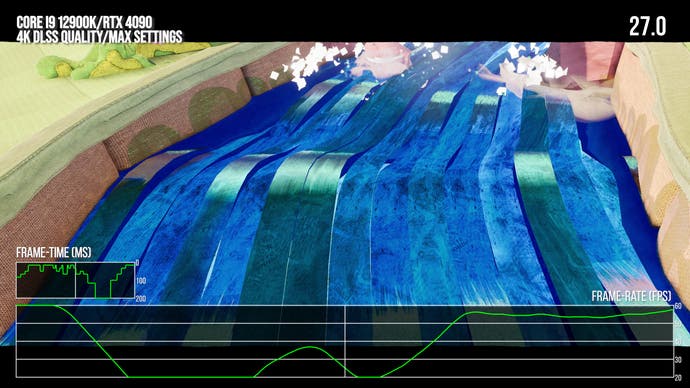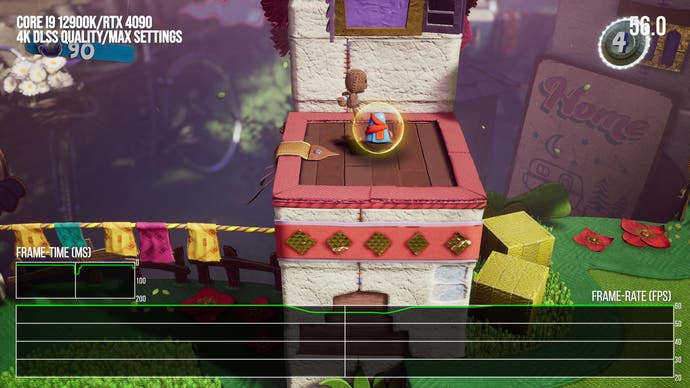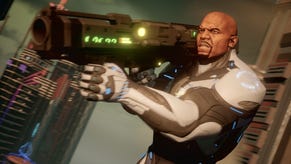Sackboy: A Big Adventure's stutter problems make a mockery of the power of your PC
Not even the most performant PC components can run this game smoothly.
I put together the intro of the video embedded on this page to highlight not just the main problem with Sumo Digital's PC port of Sackboy: A Big Adventure - but also a recurring blight on a wide range of PC titles coming to the market at this time. Rendered side-by-side against PlayStation 5, one of the most powerful and expensive gaming PCs you could conceivably build cannot the game as smoothly as the far less capable Sony console. It should be astonishing, unbelievable - ridiculous even. Instead, it's becoming the norm with a great many PC releases. It is, of course, the #StutterStruggle I've been railing against for a long time now - and it's simply unacceptable that games continue to ship in this state. And if you think the first-play experience looks bad on a top-spec PC, your mainstream rig runs even worse.
Sackboy: A Big Adventure is a perfect example of what's going wrong in the PC gaming landscape at the moment, delivering not one, but two different types of stutter, depending on how your settings are configured - and it's equally true to say that the PS5 version is completely unaffected. The problems this game has are extremely unfortunate, because elsewhere, the title is very impressive. It pains me when so much good work is being undone by basic performance problems that simply shouldn't make their way into final software.
THe good stuff begins when we first look at the game's menu system. There are a lot of options here for accessibility and control and the menus are snappy and intuitive to control. The graphical options themselves are really smartly laid out, reminiscent of those found in the PC port of Day's Gone, another Unreal Engine 4-based title. Adjusting settings sees the game shift its rendering set-up in real-time, so you can immediately see what's changed. There is even a nifty performance counter in the corner to help you get a good sense of what the change might mean for performance - a great idea! Similarly snappy is the game's loading - yes, it's slower than the PS5 in my measurements on a mid-spec NVMe drive, but just short enough to be unintrusive, making going in and out of levels fast and fluid.
These are mainly quality of life things. The most easily appreciable upgrade on PC over the PlayStation 5 version is in image clarity and anti-aliasing. PlayStation 5 operated at around 1620p with dynamic resolution scaling below that to hit 60fps consistently. On PC, you have access to native resolution rendering of course and there's DLSS on top of that too. Even in 4K performance mode upscaling from a base 1080p image, there's superior image stability and improved detail. This means that the PC version, even on a older, lower-end Nvidia GPU like an RTX 2060 can have a clearer image.
The lion's share of the other visual upgrades stem from the addition of hardware-accelerated ray tracing effects carefully chosen from UE4's RT toolbox. Three features are available, beginning with RT reflections, which offer clearly superior results over the standard screen-space alternatives - more realistic in their presentation and with far more believable interaction with materials up against SSR's mirror-like look. In the end, this makes the materials in the game look less 'video gamey' and more like those you may see in an offline render.

Other upgrades are nice to have but a little more subtle. RT ambient occlusion delivers a more realistic take on how light bounce and shading interact with the environments and are most pronounced in cutscenes - the impact during gameplay in direct lighting sees a more iterative upgrade to the standard settings. The last upgrade comes in the form of ray-traced shadows and it is the least significant upgrade of all because most of the shadows in this game are baked out as static textures - so both PC and PS5 can have some really low resolution shadows at times with obvious aliasing issues. Ray-traced shadows replace the few real-time shadows the game does have.
Beyond this, there are some other curious difference between the versions: the depth of field effect on PlayStation 5 has a kind of hard-edge pixelated look inside it that is not found at all on the PC version, while some of the art just seems different in other scenes, as you'll see explored in a little more depth in the video on this page. The differences here are mostly smaller things - almost as if Sumo iterated a touch on the game while working on the PC version.
All in all, the upgrades seem to be making use of the increased processing capacity found in modern PCs but not radically improving the game. The biggest issue is that these nice upgrades are absolutely undermined by the game's fluidity or lack of it. Shader compilation stutter is a nightmare: the first play through of this game is absolutely filled to the brim with split-second freezing. This absolutely ruins the playthrough of the game, screeching to a halt with a stutter each and every time something new happens on-screen - and no PC is powerful enough to overcome it. Move down to a mainstream gaming rig and the game feels like it is falling apart at the seams while you are playing it. As I've mentioned before, the only way to overcome this is to have someone play the game for you, caching each shader, meaning that the game runs more smoothly second time around.

More insidious in Sackboy: A Big Adventure is a second type of stutter that affected nearly all of my playthrough of the game with a jitter effect that makes a 60fps or 120fps presentation look like it's running much slower - despite the fact that actual performance is locked. It's an issue that does not affect PS5 and it's essentially an erratic form of camera movement that doesn't move in sync with the refresh rate of the game. This is obviously completely broken and affects all PCs, all GPUs and manifests whether you're on Windows 10 or Windows 11. I tested them all!
At least here, there is a fix. Basically, unless the frame-rate limiter is set to 60fps at 60Hz or 120fps at 120Hz, the broken camera stutter will kick in. I had set it to unlimited in all my testing for the game and was inducing this behaviour even while the game was running locked to 60fps with v-sync. This made me wonder if the game supports a proper variable refresh rate - and based on my testing the refresh rate varies, but the camera animation to my eye does not look as smooth as it should. So it appears that Sackboy on PC has some issue with variable frame-rates. Either way, my recommendation is to lock to 60fps or 120Hz with the game's frame-rate limiter and don't run unlocked.
The camera jitter and shader compilation stutter we're seeing here brings me back to the big issue facing PC gaming at the moment. The prevalence of shader compilation stutter is undermining otherwise quality porting efforts like this one. Sackboy is one of far too many games releasing on PC in this state, delivering a first-play experience that's massively diminished compared to the console versions - and it's just not good enough. Perhaps I'm being unfair in focusing so much on this issue on this game when so many others do it - but the issue is so bad here that it simply shouldn't have shipped in this state.









